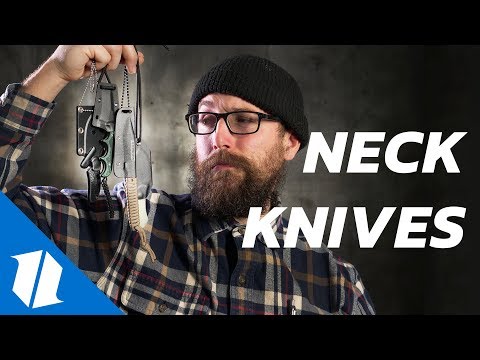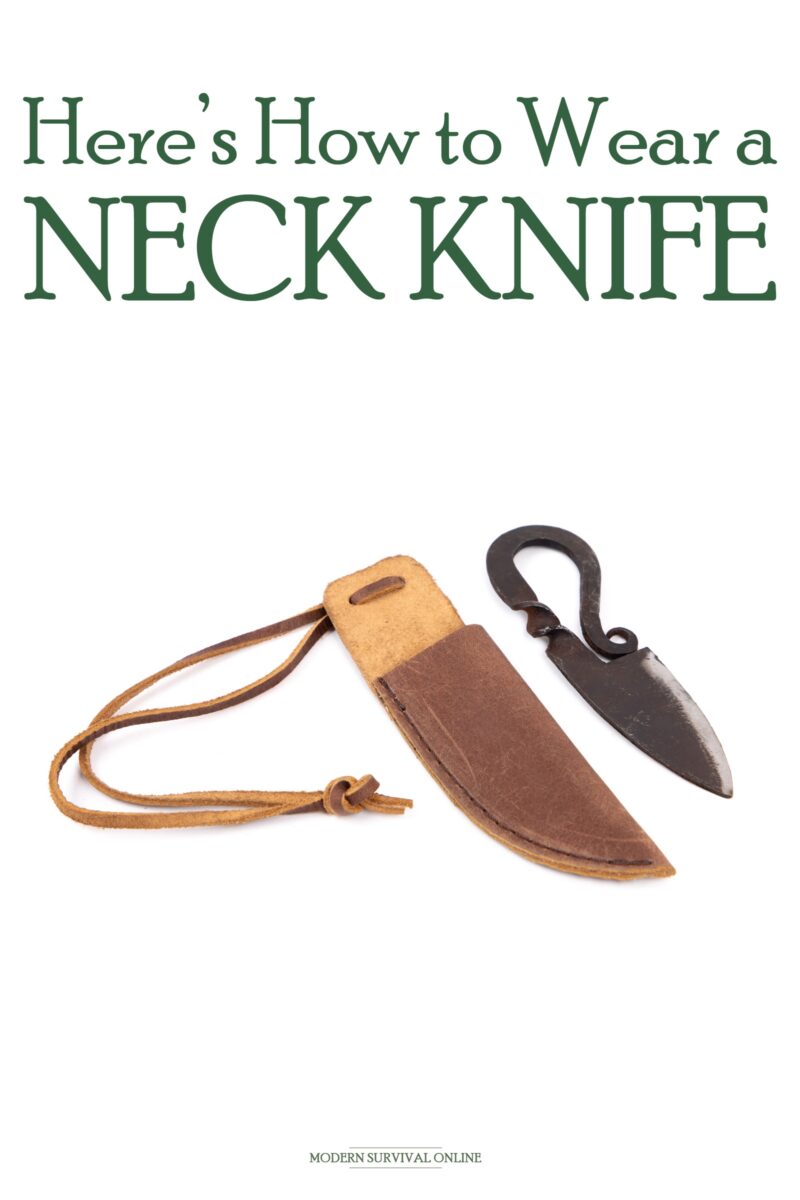You’ll rarely talk to a prepper or anyone else who practices a lifestyle of readiness that does not carry a knife with them habitually. This is a great thing, but there is one mode of carry for a blade that is chronically underutilized in my experience, and that is the neck knife.

A neck knife, as the name suggests, is a knife that is worn around the neck by way of a sheath suspended on a necklace of some sort.
Typically kept concealed beneath clothing, neck knives are a great low profile convenience option, and also work well as backup weapons or primary self-defense weapons for environments where discovery could have serious consequences.
Though the concept is simple in practice there is definitely a right and a wrong way to carry a knife in this way. Lucky for you we are here with an easy to follow guide that will show you the proper way to carry and employ a neck knife.

Step #1: Pick the Right Knife
Now, don’t go grab your favorite fixed blade knife and hang it on some chintzy piece of paracord before tossing it over your neck. That is not what a neck knife is! A proper neck knife is designed for the purpose, and it’s typically a knife that is small, lean and slender.
While it is true that any such knife carried in this way could technically qualify as such, neck knives today are purpose designed tools designed to be carried comfortably, securely and most importantly discreetly.
It does not take much imagination to envision a scenario where this knife is discovered when that is something you can least afford. A knife inside a shirt will easily reveal its outline through clothing if it is too bulky or improperly positioned, and that is precisely what we are trying to avoid.
When choosing a neck knife, you’ll generally be in the right neighborhood if you are selecting a commercially available option that is advertised as such.
But in case it isn’t clear, or the knife is capable of being carried in multiple modes, look for a knife that has a blade around 3 inches in length with a handle that will only barely afford you a full grip or even a three-fingered grip.
Also, pay close attention and make sure the sheath is as lean and as slim as possible, as the sheath is often bulkier than the knife itself.
Step #2: Choose Necklace
Before going any further, assess the necklace that you will use to carry your neck knife. If you have purchased a commercially available neck knife, chances are it will be one of two materials:
- The first is simply a length of paracord, typically knotted to form a loop.
- The second option is a beaded chain, of the type typically encountered on police badge holders or military dog tags.
Either can work, but you should be very cautious choosing either option depending on your personal context.
When considering paracord, remind yourself that this increasingly ubiquitous cord is so tough and so strong that it could strangle you or even crush your windpipe should an assailant grab hold of it or it becomes snagged in an accident.
When considering the ever popular beaded chain, do keep in mind that the appearance of such could mark you as somebody of a “tactical” lifestyle or profession.
It would not go well for you if a bad guy assumes you are an off-duty or undercover police officer or a “gun guy”! Beaded chains do have the obvious advantage of breaking away under enough force should they become caught.
Perhaps a better option is to rely on a conventional decorative or jewelry necklace, or even a simple loop of thin leather cord of the kind used to suspend a pendant.
Both should be tough enough to support the knife when it is time to draw it but be weak enough that they will yield and break when snagged.
Step #3: Set up Sheath for Tip-Up Orientation
If you have spent any amount of time around the knife sphere on or offline you will constantly hear the topic of tip orientation brought up in the context of carrying a pocket knife. Specifically, tip up and tip down carry both have their proponents, and both have advantages and disadvantages.
Without delving too far into the conversation and getting us off track in the weeds, suffice it to say that the only right way to carry a neck knife in a defensive context is with the tip pointing up, towards your head.
This is because when the drawing hand moves to access the knife it will be approaching a knife at the bottom of your upper garment. Ergo, the hand will encounter the handle quickest when the knife is carried in this orientation.
Aside from facilitating a fast, sure and natural grip on the handle of the knife it also facilitates a rapid draw as the knife will not have to be repositioned, turned or rotated in any way to begin exiting the sheath. In short, if you’re carrying a neck knife, carry it tip up.
Step #4: Get Your Clothing in Order
Now that we have our knife and have correctly chosen our necklace, the next thing we need to do is understand where we should position the knife in relation to our worn clothing.
This is a highly situational and subjective assessment based on your lifestyle, how you dress, the climate and what the consequences are for being detected carrying a weapon in such a manner.
If you are carrying a neck knife to be your first line of defense and anticipate needing it in a great big hurry, the knife should be carried directly beneath your outermost garment. So much the better if you can keep this outer garment untucked to facilitate access and speed.
If you are carrying a neck knife as a weapon of last resort or in a sensitive environment where total concealment is a mandate, you may very well keep it concealed beneath all layers of clothing to better hide its presence.
There is no universally right or wrong answer, and your specific needs and purpose for carrying the knife along with your typical attire is what will dictate the decision.
Step #5: Adjust Ride Height
There’s only one major element left for getting our neck knife properly set up for carry. Whether or not you have it set up for speed the knife should be positioned so that the sheath is at approximately the level of your sternum, somewhere along the line of the breastbone.
You might prefer yours a little higher or a little lower depending on the intersection of many variables like your need for concealment, the size and shape of the knife handle and sheath, comfort, etc.
Generally you do not want the knife to be too high or too low, as you will sacrifice speed in the former case and most likely sacrifice concealment in the latter case.
One way or the other you’ll need to adjust your necklace to raise or lower the level at which the knife rides.
Make sure you don’t institute any permanent modifications to it until you have tested it with your clothing on according to how you would typically carry! You can always take more off the necklace, but you likely can’t put it back on!
Step #6: Add Torso Strap (if required)
One optional step that you might find useful is adding a stabilizing torso strap to the sheath of your knife.
This is nothing more than an additional piece of cordage, wedding or something similar that is designed to encircle your chest while attached to the sheath, preventing the knife from flopping around while it is dangling from your neck.
This is definitely an improvement when it comes to consuming as it will prevent the knife from twisting, rolling and drooping away from the body whenever you bend over or tilt to the side.
It can also help with speed and security since it will help keep the knife in the exact same place and the same orientation every time you move to draw it.
Keep in mind; the same considerations for choosing your necklace apply to choosing your torso strap.
You want it to be sturdy enough to support the draw but weak enough to break away should it become entangled. As always, view this through the lens of how it can work against you in a fight.
Conclusion
That’s it, six simple steps to properly setting up and carrying a neck knife. Though simple in design and execution, as always the devil is in the details and adhering to the methodology presented above will ensure that your neck knife is a comfortable and seamless part of your EDC gear.

via Modern Survival Online https://ift.tt/3Kg3qda
No comments:
Post a Comment